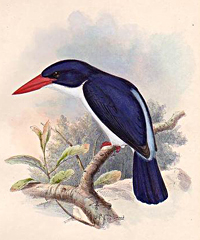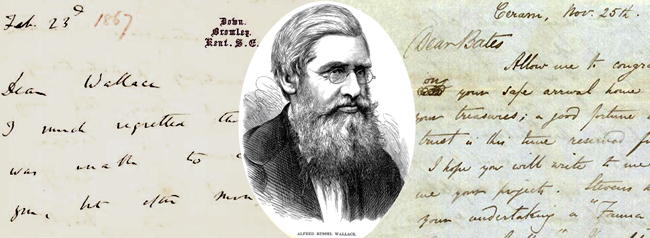Scope of the Project
The project aims to catalogue all known manuscript letters (including fragments) sent to or written by Wallace - including the original envelopes and any enclosures, plus selected letters between others which pertain to Wallace (e.g. a letter from Charles Darwin to Thomas Huxley which discusses Wallace). We will also catalogue information about letters whose text is currently unknown which are referred to in other letters or the literature, where we believe that the details given about them are accurate.
In addition to the above the project aims to catalogue the following items even though they were never part of 'posted' letters:
1) Handwritten or typed transcripts of letters to or from Wallace, especially where the original version is not known.
2) Drafts of letters to or from Wallace, even when the text of the final ‘posted’ version of the letter is known.
3) Published letters to or from Wallace, largely excluding letters which were specifically written by Wallace for publication (e.g. ‘letters to the editor’ (LTTE)). Note that all known examples of these plus transcripts, are available on the Wallace Page website and Wallace Online. Only the earliest published version of a letter will usually be catalogued, unless later versions are significantly different, in which case they too will be included. Published excerpts of letters will only be catalogued in instances where a more complete version of the letter is not known. Transcripts of published images of manuscript letters will usually only be included if the database does not already contain images or transcripts of the originals.
4) A selection of other important manuscript documents and other items which are not letters e.g. Wallace's notebooks in the NHM's Wallace Family Archive.
Project Phases
 The Wallace Correspondence Project will take place in two phases, largely because of funding considerations.
The Wallace Correspondence Project will take place in two phases, largely because of funding considerations.
Phase 1, which will run from October 2010 to November 2013, aims to achieve the following:
a) Locate as many of letters to and from Wallace as possible
b) Obtain digital scans of the letters
c) Catalogue the letters using the Project's bespoke MS Access database
d) Attempt to trace copyright holders and obtain permission to publish their ancestor's letters
e) Make the data about the letters available on the Internet via the project's web database, Wallace Letters Online
f) Make as many images of the letters available as possible via the project's web database
g) Enlist volunteers to transcribe as many of the letters as possible. These uncorrected transcripts will be made available via the online database and will be carefully checked and corrected during Phase 2 of the project.
h) Time permitting: identify all Wallace's correspondents and write mini biographies of each; index each letter with key words to enable key word searches.
 Phase 1 of the WCP will take three years, and it is hoped that Phase 2 will begin during the third year. However, this will depend on whether we are successful in securing funding for it.
Phase 1 of the WCP will take three years, and it is hoped that Phase 2 will begin during the third year. However, this will depend on whether we are successful in securing funding for it.
Phase 2 of the project has the following aims:
a) To produce detailed summaries of the letters
b) To produce scholarly annotated transcripts of all the letters
c) To discover more letters by using more time-intensive research methods than in Phase 1
d) To continue to try and identify copyright owners of the literary content of the letters in order to allow more of the images of the documents to be published online
e) To verify all the cataloguing data for the documents in the database
f) To produce a number of 'popular' and scholarly publications, in particular a Calendar of Correspondence.
This phase will be the more costly of the two, since it will require two experienced historians plus an archivist to be employed for four years each.


